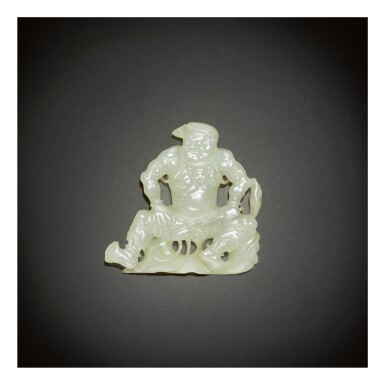Junkunc: Chinese Jade Carvings
Junkunc: Chinese Jade Carvings

AN EXCEEDINGLY RARE WHITE JADE 'GUARDIAN' PLAQUE, YUAN DYNASTY
Auction Closed
September 22, 03:56 PM GMT
Estimate
50,000 - 70,000 USD
Lot Details
Description
AN EXCEEDINGLY RARE WHITE JADE 'GUARDIAN' PLAQUE
YUAN DYNASTY
元 白玉雕天王牌
of flattened form, the muscular figure depicted seated on pierced rockwork with one hand resting on the leg and the other holding a mace, wearing a bejeweled necklace suspending a skull over the bare upper torso, the trousers secured at the waist by a belt draped with a long sash, the face rendered with a fierce expression detailed with a downturned mouth, large rounded eyes and thick brows, the base with two apertures for attachment, the lustrously polished stone of an even color
Height 2⅜ in., 5.9 cm
C.T. Loo, New York, 7th December 1946.
Collection of Stephen Junkunc, III (d. 1978).
來源
盧芹齋,紐約,1946年12月7日
史蒂芬•瓊肯三世(1978年逝)收藏
The present plaque is highly idiosyncratic and remarkably rare, with only one other closely related example recorded of the same size and carved out of gray jade with a nearly identical rendering of the guardian, attributed to the Yuan dynasty, in the collection of Frank Wu, the former president of the Min Chiu Society, included in the exhibition The Grandeur of Chinese Art Treasures: Min Chiu Society Golden Jubilee Exhibition, Hong Kong Museum of Art, Hong Kong, 2010, cat. no. 204.
This unusual figure, portrayed powerfully with a muscular body, wearing a skull-decorated necklace over the bare upper torso, a ferocious expression with monstrous features, and a distinctive hairstyle formed by two tufts of hair swept to the side, depicts a Buddhist guardian. Its image resembles closely the attendant guardians on the monumental stone panels carved with the Four Heavenly Kings under the arched passage of the Cloud Platform at Juyong Pass, Beijing, which was constructed between 1343 and 1345; see the guardian beneath Virupaksa, the King of the West, very similarly depicted and posed, but without the attribute, illustrated in Zhongguo meishu quanji. Diaosubian. Yuan Ming Qing diaosu [The complete series on Chinese Art. Sculpture. Yuan, Ming and Qing dynasties], vol. 6, Beijing, 1988, pl. 15.
The iconography of these demonic guardians, as attendants of the Heavenly Kings, appears to have been developed at least by the Tang dynasty. Compare the attendant guardians on a Tang gilt-silver reliquary, which was discovered at the Famen Monastery, Shaanxi province. Each side of the reliquary is chased with one of the Four Heavenly Kings, accompanied by similarly rendered guardians holding various attributes; see the exhibition catalogue Everlasting Like the Heavens. The Cultures and Arts of the Zhou, Qin, Han, and Tang, The Tsinghua University Art Museum and Shaanxi History Museum, Beijing and Shaanxi, 2019, pp 450-455.
By the Liao dynasty, images of these guardians also appeared in pairs as door gods. See two standing guardians, one holding a spiked mace, the other holding a sword, identified as Shentu and Yulei, the mythological gods responsible for protecting gates, painted on a pair of funerary doors, unearthed from a Liao dynasty tomb in Bayanerdeng, Inner Mongolia, exhibited in Empires Beyond the Great Wall. The Heritage of Genghis Khan, Natural History Museum of Los Angeles County, Los Angeles, 1993, fig. 74.
本品極罕,目前僅知另有一例存世,尺寸相同,玉質灰白,斷代為元,所雕天王形象及姿態與本品一致,敏求精舍前主席胡家麟收藏,展《博古存珍•敏求精舍金禧紀念展》,香港,2010年,編號204。
本天王形象,體魄雄健,赤裸上身,飾人骨項鍊,面呈怒鬼相,兩側立髮拂至一旁。此形象與北京居庸關雲台卷門內壁四大天王雕飾中的鬼相天王近同。該雲台建於元至正三年至五年之間。可比一例,見於西方廣目天王下方,形象尤近,但無法器,載《中國美術全集•雕塑編•元明清雕塑》,卷6,北京,1988年,圖版15。
此類天王形象,作為四大天王之輔眾,最晚於唐代已見。參考陝西扶風法門寺地宮發現的鎏金四天王盝頂銀寶函,四面鏨四大天王像,並輔以相似形象的鬼相天王,手持各式法器,見展覽圖錄《與天長久•周秦漢唐文化與藝術》,清華大學藝術博物館及陝西歷史博物館,北京及陝西,2019年,頁450至455。
至遼代,此天王形象亦見作為門神成雙出現。參考兩立像,其一手持骨朵,其二手握寶劍,應為古代門神神荼與鬱壘,繪於兩扇墓室木門之上,出土於巴林右旗巴彥爾登遼墓,現存林西縣文管所,展《Empires Beyond the Great Wall. The Heritage of Genghis Khan》,洛杉磯縣自然歷史博物館,洛杉磯,1993年,圖74。
